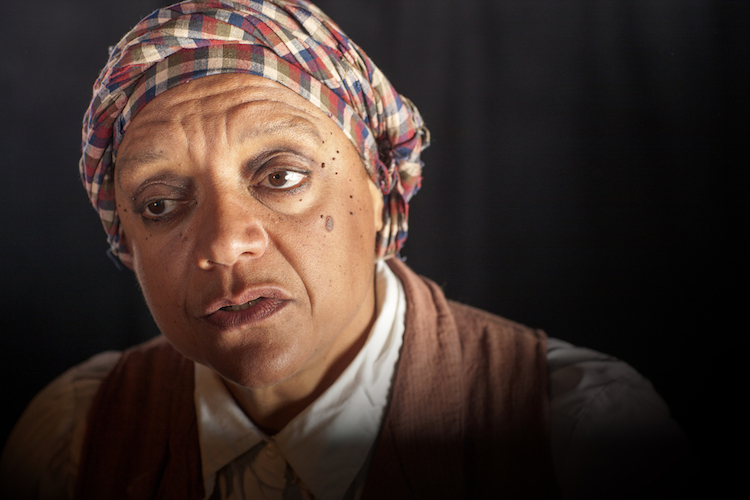Portrayed by Becky Stone
Harriet Tubman is best known for escaping slavery and helping others to do the same along the famed Underground Railroad. But no single act in Tubman’s life would free more people than the Combahee River Raid, right here in South Carolina.
What kind of courage does it take for a fugitive slave to return to the South to serve the Union army without pay – nurse the wounded – sneak into Confederate South Carolina to spy and recruit slaves – and ultimately lead soldiers with Col James Montgomery to raid rice plantations along the Combahee River in South Carolina freeing 700 or more slaves?
Shows Schedule
 Becky moved to Western North Carolina from Philadephia, PA 40 years ago and discovered storytelling. Already a trained actor, Becky found storytelling to be a delightful change. She has performed as a teller, an actor, singer, and dancer for 45 years while raising 4 children, teaching, directing, and co-publishing a small garden quarterly, GreenPrints, with her husband who is the editor. Becky began her Chautauqua career in 2002 when Greenville recruited her to portray Pauli Murray. Since then, she has done Harriet Tubman and Rosa Parks in Greenville, Colorado, and many schools, museums, and libraries in North Carolina. Although Harriet Tubman was a powerful woman ensconced in a 5′ foot body, Becky she needs every inch of her 6′ foot body to portray this larger than life – courageous hero. Becky holds a BA from Vassar College in drama and a MA in Education from Villanova University and for 20 years has been is a regular story-teller at the Biltmore Estate.
Becky moved to Western North Carolina from Philadephia, PA 40 years ago and discovered storytelling. Already a trained actor, Becky found storytelling to be a delightful change. She has performed as a teller, an actor, singer, and dancer for 45 years while raising 4 children, teaching, directing, and co-publishing a small garden quarterly, GreenPrints, with her husband who is the editor. Becky began her Chautauqua career in 2002 when Greenville recruited her to portray Pauli Murray. Since then, she has done Harriet Tubman and Rosa Parks in Greenville, Colorado, and many schools, museums, and libraries in North Carolina. Although Harriet Tubman was a powerful woman ensconced in a 5′ foot body, Becky she needs every inch of her 6′ foot body to portray this larger than life – courageous hero. Becky holds a BA from Vassar College in drama and a MA in Education from Villanova University and for 20 years has been is a regular story-teller at the Biltmore Estate.
“Nothing that comes to this remarkable woman ever surprises her. She says very little in the way of thanks, except to the Giver of all good. How the knowledge comes to her no one can tell, but she seems always to know when help is coming, and she is generally on hand to receive it, though it is never for herself she wants it, but only for those under her care . . . ” — Sarah Bradford, friend and biographer
“He is the most of a man I have ever met with.” — John Brown, abolitionist (Brown consciously used the male pronoun. He called Harriet “General”)
“She was cautious, cunning, and brave.” — Harkless Bowley, son of Tubman’s niece
“We have had the greatest heroine of the age here.” — Col. Thomas Wentworth Higginson, Civil War Union Officer, Department of the South
“I can’t die but once.” — Harriet Tubman
We know courage when we see it. Often it involves doing something for someone else, taking risks that we would not take if we were thinking of our own survival.
When Tubman began her journey to freedom from Dorchester County, Maryland to Philadelphia, Pennsylvania in 1849, she had no idea that she would become an Underground Railroad Conductor and the only conductor to successfully return time after time to bring family and others through to the North. When Tubman brought the last of her family through she thought she was done with the South. Little did she know that she would return deeper into the South than she had ever been in order to serve her country during the Civil War. Did she even dream that she would serve as a spy, lay the groundwork for and help lead a successful raid into Confederate territory? Did she realize that emancipation would draw her into the service of helping freedmen gain footing in their new life, or that she would feel the responsibility to cry out for the female citizens of the United States to have the right to vote? Tubman’s life in slavery, along with her God-given intelligence, strength and charisma, equipped her to do this work.
Tubman’s mother was a house slave. Her owners assumed that Minty (Harriet’s given name was Araminta.) would be a house slave, too. Harriet was hired out during her childhood to work in white folks’ houses. The work did not suit her. She was too small and weak to survive under the abuse and neglect of those who “rented” her. She was returned to her home plantation, the Brodess plantation, weak and sick where her mother nursed her to health using her knowledge of medicinal roots, herbs, potions and poultices. Harriet learned those skills from her mother and later used them to nurse black Union soldiers in South Carolina during the Civil War.
Minty sustained a severe head injury when she was a pre-adolescent. Minty was in the line of fire when a white man, probably an overseer or owner, picked up a lead counterweight from the counter of the general store to hit a slave who was running away. He hit Minty on her left temple instead. Unconscious for days and therefore no longer a good investment for her temporary owner, Minty was returned to the Brodess plantation. Her mother nursed her to health, but Minty was so small, sickly, and suffering from disabling headaches, that Master Brodess could no longer rent her out for profit. They got as much work as they could out of her in the field. There Minty thrived. She was still plagued by headaches, but she grew stronger and healthier.
Minty was a hard, determined worker and most often worked for her father, Ben Ross, who managed the timber business on the nearby Stewart plantation. Minty learned how to find her way in the woods and marshland of Maryland’s Eastern shore. All of those skills came to good use when she was a spy for the Union in coastal South Carolina.
Most significantly, the head injury seemed to precipitate Harriet’s dreams, visions, and her passionate prayers to God. She was a woman with deep faith in God as her friend and protector. God directed her every move, and she was obedient. She would do whatever He told her to do all of her life, and when it was time to “go”, she said, she’d be ready.
And herein lies the significant thing about Harriet’s courage. Courage usually denotes overcoming fears. Harriet survived many fearful situations – traveling in disguise, guiding fugitives, stealing information as a spy, etc. But she had no fear. She did what God told her to do. He never failed her. Her work was always for others, never herself. She was action-oriented – always ready to speak out, to physically fight, to resist for others. Tubman was a great patriot. She saw her work with fugitives and freedmen as a way of lightening the load on the government. She did not hesitate when the governor of Massachusetts, John Andrew, recruited her to serve as a Union spy.
Harriet Tubman was fully equipped to serve her country in the Civil War. She knew how to navigate the backwaters of coastal Carolina. She developed a relationship with the Gullah community that enabled her to recruit a network of spies. She left the soldiers’ camps and lived on her own doing laundry and cooking to make a living, and was able to teach those wage-earning skills to the “contraband”. She had the strength and stamina to serve as a nurse when Hilton Head and Port Royal, SC were overwhelmed with wounded soldiers. Her skill in curing disease was well known. The Union surgeon in charge sent Tubman to Fernandina, FL where she saved soldiers who were dying from dysentery. She was humble. She asked for what was her due and for help when needed, but always for others. For every exploit that left abolitionists and fugitives awed (Her sleeping spells and visions after the head injury added to her mystique.), she gave all glory and credit to God.
Was Harriet Tubman a model of courage? Yes, a model for all of us, if not for herself.
- 1822 – Aramintha “Minty” Ross, later known as Harriet Tubman, born on Anthony Thompson’s plantation in the Peters Neck district of Maryland, but will belong to Edward Brodess when Brodess turns 22
- 1828-1835 – Young Minty is hired out by Brodess to various masters, some cruel and negligent (Ages 7 – 13)
- Sometime between 1834-1836 Minty is struck on the head by an iron weight which nearly kills her. (Approximately 12,13, or 14 years old)
- 1844 – Minty marries freeman John Tubman and takes the name of Harriet ( 22 years old)
- 1849- Edward Brodess dies leaving his widow saddled with debt. Harriet runs away after hearing she might be sold. (27 years old)
- 1850 – The Fugitive Slave Act is passed. Harriet runs her first rescue mission, helping her niece Kessiah and her two children escape
- 1850 – 1860 – Harriet runs approximately 13 trips from Maryland and rescues about 70 individuals from slavery (ages 28 – 38.) Harriet brings her aged parents through to freedom (1857) – meets and helps John Brown plan his raid (1858) – dramatically rescues fugitive slave, Charles Nalle, in Troy, NC (1860) and continuously speaks for the Abolitionist Movement.
- 1861 – The Civil War starts with the firing on Ft. Sumter in SC
- 1862 – Harriet begins to work as a cook, nurse, laundress, scout, spy for Union forces at Hilton Head, SC (Age 39)
- 1863 – The Combahee River Raid – Under the command of Col. James Montgomery, Harriet leads an armed raid where they rout Confederate forces and free 750 slaves
- 1863 – Harriet witnesses the failed Union attack of Ft. Wagner
- 1865 – The Civil War ends. Harriet returns to her home in Auburn, NY where she farms, does domestic work, and takes care of African Americans in need. (Age 42)
- 1867 – John Tubman murdered in Maryland
- 1869 – Harriet marries Nelson Charles Davis, a young man 20 years her junior (Age 47)
- 1871 – Father, Ben Ross, dies
- 1873 – William Seward sells her a home in Auburn, NY (Age 51)
- 1880 – Mother, Rit Ross, dies
- 1888 – Nelson Davis dies from tuberculosis
- 1890’s – Harriet becomes active in the suffrage movement (Ages 68-78) – Harriet undergoes brain surgery in Boston to relieve headaches – Harriet purchases land to establish a home and hospital for African Americans adjacent to her home
- 1908 – The Harriet Tubman Home is opened by the AME Zion Church to which Harriet had transferred ownership in 1903.
- 1911 – Harriet enters the home as a patient (Age 89)
- 1913 – Harriet dies from pneumonia and is buried next to her brother in Auburn, NY (Age 91 or 92)
- God won’t let Mr. Lincoln beat the South till he does the right thing. I’m a poor Negro; but this Negro can tell Mister Lincoln how to save the money and the young men. He can do it by setting the Negroes free.
- I’ve heard ‘Uncle Tom’s Cabin’ read, and I tell you Mrs. Stowe’s pen hasn’t begun to paint what slavery is as I have seen it at the far South. I’ve seen the real thing, and I don’t want to see it on no stage or in no theater.
- It wasn’t me; it was the Lord! I always told Him, ‘I trust to you. I don’t know where to go or what to do, but I expect You to lead me,’ and He always did.
- Now I’ve been free, I know what a dreadful condition slavery is. I have seen hundreds of escaped slaves, but I never saw one who was willing to go back and be a slave.
- The Lord who told me to take care of my people meant me to do it just as long as I live, and so I did what he told me.
- And then we saw the lightning, and that was the guns; and then we heard the thunder, and that was the big guns; and then we heard the rain falling, and that was the drops of blood falling; and when we came to get in the crops, it was dead men that we reaped.
- I can’t die but once.
- Harriet Tubman – The Road to Freedom by Catherine Clinton (2004) Thoroughly researched and beautifully written. Brings clarity and some understanding to life in Maryland during slavery, the workings of the Underground Railroad, the Abolitionist movement, the Department of the South in the Civil War, and the struggles of freemen as well as fleshing out the details of Harriet’s life. It flows and is easy to read.
- The Combahee River Raid – Harriet Tubman and Lowcountry Liberation by Jeff Grigg (2014) Provides insight into the white military leaders in the Department of the South, the politics and strategies involved. Gives a detailed account of the raid. It’s a fairly dry read.
- Harriet Tubman – The Life and the Life Stories by Jean Humez (2004) Crisp narrative of Tubman’s life and pages and pages of quotes from Harriet, letters, books, articles about her, excerpts of documents. Very readable. Well organized, making it easy to find points of interest.
- Harriet Tubman – Portrait of An American Hero – Bound for the Promised Land by Kate Clifford Larson (2004) Engaging narrative that gives details and insights about the world Tubman lived in and Tubman’s character. Well-researched. Maps, timeline, family tree, and notes are very helpful. I recommend this book and Clinton’s book for accuracy and readability.

